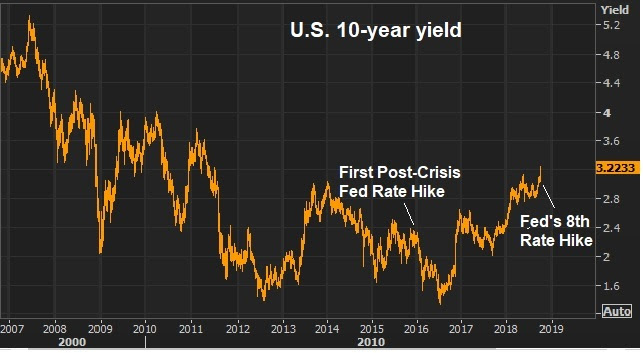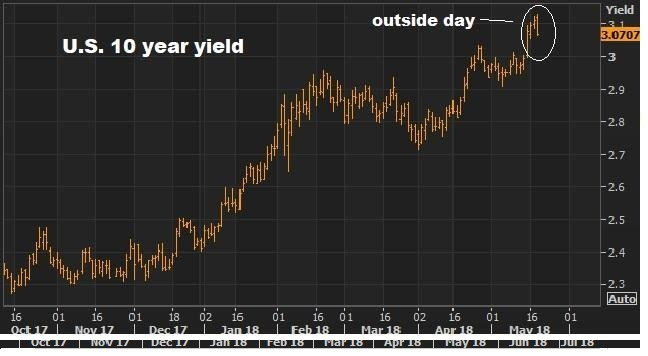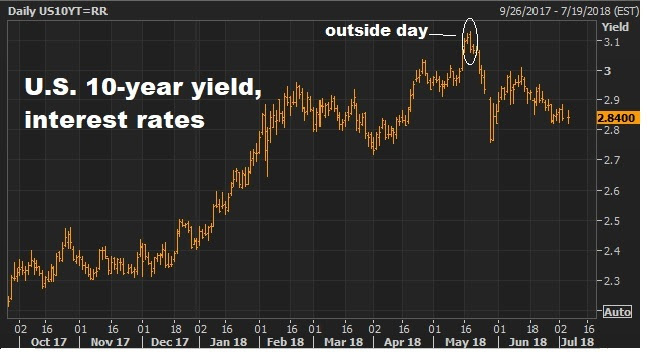November 27, 5:00 pm EST
Earlier this month, we talked about the big fall in oil prices.
If we look back over the past five years, the magnitude of that move is only matched (or exceeded) in cases where there was significant manipulation in the oil market and/or a systemically threatening oil price crash.
As we’ve discussed, the pressure on oil this time around seems to be about manipulation — and appears to have everything to do with Trump’s leverage over the Saudis (related to sanctioning the Kingdom over the Khashoggi murder).
But we’ve now traded down to the important $50 mark. That’s 35% from the highs of just October 3. And this is an inflection point where it could go bad, but it also could present a goldilocks scenario (a level that’s just right for the U.S. economy).
Sure, cheap oil is good for consumers. You save a few extra bucks at the pump. But in the current environment, it presents risks to the financial system. The shale industry’s break-even point on producing oil is said to be $50. Below that, they dial down production, lay off workers, stop investing and quickly become a default risk to their creditors (U.S. and global banks). We saw it back in 2016. The same can be said for those countries heavily dependent on oil revenues (i.e. they become default risks as oil prices move lower).
That’s the bad side. The good side to the oil price slide? As we’ve discussed, it should relieve some pressure on the Fed. The Fed likes totalk about their inflation readings excluding effects of volatile oil prices. But they have a record of acting on monetary policy when oil is moving.
The bottom line: Oil plays a big role in their view on inflation. And given the quick drop in oil prices, the Fed’s concerns about inflation should be cooling. Again, this opens up the door for the Fed Chair, tomorrow, to take the opportunity in a prepared speech at the Economic Club of New York, to signal a pause coming in the Fed’s rate normalization program. That would be a positive catalyst for economic and market confidence.
What stocks do you buy? Join me
here to get my curated portfolio of 20 stocks that I think can do multiples of what broader stocks do, coming out of this market correction environment.
November 13, 5:00 pm EST
In the past two notes, I’ve focused on oil. And that does indeed seem to be the tail that is wagging the global markets dog.
Oil lost another 8% today. Over the past 31 days, crude prices have dropped 27%.
If we look back over the past five years, the magnitude of that move is only matched (or exceeded) in cases where there was significant manipulation in the oil market and/or a systemically threatening oil price crash.
You can see in the chart above, we’ve dropped 27% over the past 31 days. The other big drops in crude were in February of 2016 (the crash) and in November of 2014 (OPEC’s refusal to cut oil production).
Interestingly, these historic crude price declines were occurring as the Fed was preparing markets for the beginning of its normalization campaign (i.e. moving rates away from the emergency zero interest rate level). And it was these price declines that threw a wrench in those plans.
Despite what the central bankers say, oil prices have a big influence on their read on inflation. Lower oil prices put downward pressure on inflation. And as oil prices were plunging from 2014 through 2016, the Fed clearly and dramatically held back on their rate hiking plans.
On that note, remember yesterday we talked about the prospects that Powell (Fed Chair) may use the opportunity to dial down expectations of a December rate hike, if we see some soft data this week (growth data from Japan and Europe and inflation data from U.S., Europe and UK). We now have a big haircut on oil prices to factor into the inflation data. That too, may give him the excuse to pause on rates. We’ll hear from him tomorrow at a Dallas Fed meeting.
Join me
here to get all of my in-depth analysis on the big picture, and to get access to my carefully curated list of “stocks to buy” now.
November 12, 5:00 pm EST
Stocks continue to swing around following last weeks midterm elections. Perhaps it has something to do with the uncertain outcome that remains in Florida, given the role Florida will play in the 2020 Presidential election. Perhaps it has something to do with the continuation of the unraveling of the tech giants.
Maybe more importantly, we head into a week with key inflation data hitting for the U.S., Europe and the UK. And we have Q3 GDP numbers coming from Japan and Europe. The Japanese economy is expected to have contracted last quarter.
Slowing numbers in Japan and Europe, along with some tame inflation data might give the Fed Chair (Powell) an excuse to dial down expectations of a December Fed hike. He is scheduled to speak Wednesday afternoon at a Dallas Fed event.
With the idea that the new divided Congress will put the brakes on any new pro-growth economic policies, Powell may be looking for the excuse to slow the pace that rates are rising. That would be a huge catalyst for stocks.
Join me
here to get all of my in-depth analysis on the big picture, and to get access to my carefully curated list of “stocks to buy” now.
The move in rates continued to spook markets today. The 10-year yield traded as high as 3.23%.
Now, despite the dramatic tone you’ll find on CNBC when stocks go down, a 10-year yield at 3.23% isn’t a crisis. And a stock market that is down 1% from all-time highs isn’t a crisis or even a “sell-off.”
For perspective, the Fed has now moved 8 times off of zero. The leaves the benchmark (short term) rate set by the Fed at 2-2.25%, still well below long-term average rates. And that leaves the market determined (longer term) interest rate, just below 3.25%, still well below the long-term average. With that, rates are still low. In fact, if we took the record low in the 10-year yield, set in July of 2016, and applied the Fed’s 200 basis points of hikes, we would have a 10-year of 3.34%. We are still south of that. I would argue at current levels, the interest rate market is finally pricing in sustainable economic recovery (pricing out risks of another post-economic crisis shock/slump).
Now, when rates are on the move, people immediately start talking about debt service. On that note, consumers and companies are in as good a financial position as they’ve been in a very long time (record high household net worth, record profits) . Household debt service ratios are at record lows.
Bottom line, the move in rates is a growth story, not a crisis story. We have 3%+ economic growth, with low inflation and solid employment. We may have finally returned to the level of trust and confidence in the economy that fuels “animal spirits.”
Attention loyal readers: The Billionaire’s Portfolio is my premium advisory service. And I’d like to invite you to join today, as we are beginning what I think will be a tremendous run for value stocks into the end of the year. It’s a great deal for the money. Just click here to subscribe, and get immediate access to my full portfolio of billionaire-owned stocks. When you join, you’ll get immediate access to every recommendation–past, present and future–in the portfolio. And I’ll deliver my in-depth notes on our portfolio and the bigger picture every week, directly to your inbox.
September 26, 5:00 pm EST
The Fed moved again today on rates, as the market expected. This is the eighth quarter point hike in this post-QE normalization on rates. And this now puts the Fed Funds rate at the range of 2%-2.25%.
Now, the markets will pick apart the statement and endlessly parse the Fed Chair’s words in the press conference. But let’s step back and take a look at the impact of these Fed hikes thus far.
We know the economy is running at the best pace since before the financial crisis. We know that the jobless rate is near record lows. We know that consumer credit worthiness is at record levels. This has all happened, despite the Fed’s rate hikes.
What about debt service coverage? As rates are moving higher, are consumers showing signs of getting squeezed?
If we look back at the height of the credit bubble in 2008 (just prior to its burst), 13.22% of household income was going to service debt–within that number, 7.2% of household income was going to service mortgage debt. What about now? Debt service is now 10.2% of household income. And the mortgage piece is down to just 4.4%. This is the result of six years of zero interest rates, a massive QE program (which included the Fed’s purchase of mortgage bonds), and a government program that subsidized banks to refi high interest rate mortgages.
So the big question is, how has the Fed’s exit of QE effected the consumers ability to service debt? Are higher rates hurting?
Well, they started hiking rates in the fourth quarter of 2015. Total debt service at that time was 10.1%. That’s virtually unchanged from today. And the mortgage piece was 4.5%. That’s actually a touch higher than today.
Bottom line: The Fed’s normalization on rates has not damaged the consumer, nor has it killed the housing market.
But that’s only because the yield curve has been flattening. That is, longer term market interest rates have been steady. That means the benchmark rate from which consumer and mortgage rates have been set, has been steady. And those longer term rates have been steady, in large part, because Europe and Japan have remained in QE mode (buying global assets, which includes our Treasurys).
With that, while most have been watching the Fed closely for how it’s delicately handling the exit of QE, the more important spot to watch will be how Europe and Japan manage their exits. Hopefully, the U.S. economy is hot enough, at that point, to withstand the move in longer term U.S. rates that will come with the end of global QE.
If you haven’t joined the Billionaire’s Portfolio, where you can look over my shoulder and follow my hand selected 20-stock portfolio of the best billionaire owned and influenced stocks, you can join me here.
June 13, 5:00 pm EST
Watching the media and expert community digest the Fed decision is always interesting.
They are all programmed to home in on the worst-case scenario. It’s very similar to the way they parse politics.
In this case, the Fed projected an extra rate hike this year. They were projecting three hikes for 2018. Now they are projecting four hikes for the year (two of which are now in the rear-view mirror). Why an extra hike? Is it because they want to disrupt the recovery and undo all of their efforts of the past decade to manufacture that recovery? No. It’s because they think the economy is good! In fact, Powell (the Fed Chair) said “the main takeaway is that the economy is doing very well.”
And when asked about the impact of tax cuts, he said, we’ve yet to see the benefits. But, it should “provide significant support to demand over the next three years … encourage greater investment … and drive productivity.” This is exactly what we stepped through last week in my Pro Perspective notes (here). We laid out the components of GDP (consumption, investment, government spending and net exports) and we talked about the setup for positive surprises feeding into an economy that’s already running at near 3% growth — because pro-growth policies are just beginning to show up in the data!
With that, it should be no surprise that the Fed feels more comfortable telegraphing another hike, from what is still very low levels of interest rates.
Now, what is the negative scenario the pundits have been harping on? The yield curve. With the Fed gradually walking up short term rates (rates they set), the benchmark market interest rates (namely the 10-year government bond yield) has been soft. That creates yield curve flattening, which gets the bears excited that a yield curve inversion could be coming (a good historical predictor of recession).
Why is the 10 year yield soft? As we’ve discussed, the two major central banks that are still in the QE game have been anchoring longer term interest rates through their outright purchases of global government bonds (including lots of U.S. Treasuries, which keeps a cap on yields).
On that note, we have the ECB tomorrow. And the Bank of Japan will meet on monetary policy tomorrow night. The trajectory of global monetary policy is UP. And the more the Fed does, the more it forces that timeline elsewhere in the world to follow the Fed’s path on normalizing rates. The ECB will be following the Fed normalization path soon. And the Bank of Japan will be last. And when we get hints that it’s coming sooner rather than later, the yield curve will start steeping, and the bears will have a very hard time justifying their “sky is falling” view.







